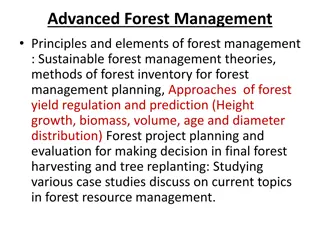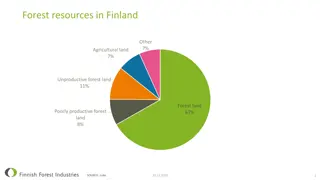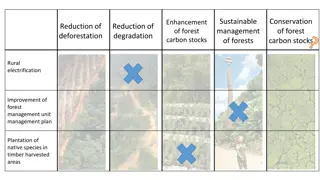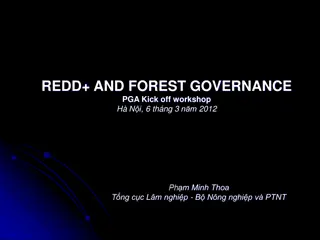
Importance of Forest Inventory for Effective Management
Forest inventory plays a crucial role in assessing forest resources, such as composition and biodiversity, facilitating sustainable management decisions. It involves methods like ground-based surveys and remote sensing to collect data for planning activities and monitoring forest health.
Download Presentation

Please find below an Image/Link to download the presentation.
The content on the website is provided AS IS for your information and personal use only. It may not be sold, licensed, or shared on other websites without obtaining consent from the author. If you encounter any issues during the download, it is possible that the publisher has removed the file from their server.
You are allowed to download the files provided on this website for personal or commercial use, subject to the condition that they are used lawfully. All files are the property of their respective owners.
The content on the website is provided AS IS for your information and personal use only. It may not be sold, licensed, or shared on other websites without obtaining consent from the author.
E N D
Presentation Transcript
Mrs. Sonia Panigrahi Assistant Professor
Introduction: Silviculture is the branch of forestry which deals with the establishment, development, Care and reproduction and stands of timber Definition: It has been defned variously as follows: By Toumey and Korstain: Silviculture is that branch of forestry which deals with the establishment, development, care and reproduction of stands of timber.
By Champion and Seth: The terms silviculture, in English refers only to certain aspects of the theory and practices of raising of forests crops. By FRI Dehradun It is the art and science of cultivated forests crops. On the other hands, Silvics is the study oflife history and general forest trees and crops with reference to environmental factors. Thus, silviculture can be described to include all practical and theoretical aspects of silvics. characteristics of Particular
Study of silviculture helps to attain the following object: 1. To derive environmental benefits: Soil and water conservation, control of air and noise pollution, wild life conservation, regulation of climatic condition, regulation of water cycle. 2. Raising species of more economic value: Industrial and economic growth through.
3.Production of high-quality timer: Silviculture techniques help of avoid the problem of crooked, malformed, timber and thus help to produce goods quality timber. 4. Production of more volume per unit area: Unmanaged forests may be too dense or too open, less production, premature death of trees silviculture helps to solve these problems. disease or defective
Reduction Unmanaged forests the rotation tends to be longer. 6. Afforestation of blank areas: Waste lands can be used for forests 7. Creation of plantation: Man made forests or plantations may be created in placed of natural forests. 8.Introduction of introduction of exotic species is possible. 9. Employment potential: In any plantation operation, the labour component account for 60 to 70% of the total fnancial input. of rotation period: In 5. exotics: Successful
10. Increase in the production of fuel and fodder: In development countries like India it is important aspect. 11. Forest Industries: Resin for resin and turpentine industry, pulp wood for paper industry, industrial wood for match and timber industry, railway, etc, minor forests product based industries
1. Control of Crop Composition and Production of Species of More Economic Value: Under natural conditions, a large number of species form the crop inferior or less valuable species may fourish at the expense of the desirable species. The control is exercised by two ways: i. By removing or cutting inferior species ii. By creating more favourable conditions for the regeneration and growth of desirable species.
2. Control of Stand Density, for Production of Maximum Volume: In the natural forests, trees are likely to grow either too dense or too open. If the trees are too dense-the wood production is distributed over large number individuals and none of them grow to the optimum size. If the trees are too less, the production would be less, though individual trees may grow sufficiently with higher dimensions.
If the trees are too less, they will not be able to utilise the site, effectively and may be even inadequate to regenerate the area. Both these conditions are not good for maximum wood production. Silviculture helps to maintain or retain sufcient number of trees per unit area so that by optimum use of soil, maximum wood production is ensured. Substantial increase in production can be ensured by thinning dense prop through salvaging the trees otherwise these trees would have died.
3. Afforestation of Blank and Under Stocked Areas: There is a large area of forests which is blank or under stocked due to free, encroachments, illicit fllings, or some natural causes. These areas are however, suitable to bear tree growth. Silviculture helps us to afforest these areas with suitable trees by planting or by seedling. Silviculture guides to know the best period of seed collection, nursery technique, plantation details, etc. to complete afforestation.
4. Production of Quality Timber: In unmanaged forests, because of intense competition or little competition, quality timber is not produced. A large number of trees are malformed, defective and sometimes diseased. Proper control of damaging agencies can increase the production. Insects,fungi,wind, grazing,lopping, etc. which affect the quality of the timber are controlled silvicultural techniques and methods by suitable
5. Control on Rotation Period: Rotation is counted period in years from regeneration to harvesting. In unmanaged forests, if there are more number of trees, the growth of individual tree is slow consequently, they take longer period to reach to harvestable size. The knowledge of silviculture helps to regulate the density of the crop at various sizes / ages which helps to reach exploitable size much faster. Thus, rotation of a crop can be reduced by regulating the density of the crop. It also helps in identifying short rotation crops.
6. Facilitate Management and Use of Forests: In unmanaged forests, good forests exist in difcult areas, where it is difcult to manage and harvest the timber. In managed forests, it is easy to plant the growth and distribution of forests so that the produce is used efciency and economically. It is possible to arrange the forest in different localities in such age classes and species composition that management becomes easy.
7. Creation of man made forest and introduction to exotics: Silvicultural techniques help us to replace wholly or partly, natural forests by man mad forests of the same species or by other species. If the existing, forest does not contain valuable and the desirable species. It can be planted with such important species. If the forest consists of desirable species but it is not regenerating properly, it can be harvested and regenerated artifcially. Identifcation of suitable exotics depending upon geographical location, raising trail, plantations, selection of suitable exotics species, perfecting the nursery and plantation techniques of the exotics are some of the silvicultural techniques which help in introduction of exotic species on a large scale.
8. Protection of Site and Intangible Returns: The main object of silviculture is to provide maximum protection to the site so that intangible returns from the forests are ensured. Important intangible returns include, moderating climate, increasing precipitation, reducing soil erosion and foods conserving soil and water increasing water yields providing shelter to a large number of wild animals, etc. Silviculture helps to understand the requirement of a tree and its effect on the site. The species, which are likely to deteriorate the site, are discarded. Only such species which afford complete protection to the site and ensure continuous flow of intangible benefits are preferred.






















